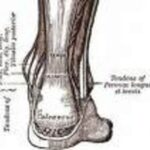I injured the tendon that joins my quadriceps to my kneecap when I was doing ultra-heavy leg extensions.
I didn’t go see a doctor because what could a doctor do? Most of the time, they can’t figure out what exactly you injured anyways.
So I self-diagnosed myself as having an injured quad tendon. The location of the funny discomfort was a dead giveaway to what was wrong. The location was right where the tendon would be. Tendons join muscles to joints. Secondly, I can differentiate between tendon pain and muscle pain. If you’ve ever had strained or injured tendons, you know what I’m talking about. The discomfort is unique, nothing like muscle discomfort.
A common way of injuring a tendon is to overload it during weight lifting, which is exactly what I did. As I was bringing my leg up during the extension, I suddenly felt this pain. It wasn’t sharp like a knife, but it was very noticeable, and concentrated in a small area just above my kneecap.
Quadriceps muscles are very durable and strong. This was no quad injury. It was clearly the tendon. When you injure a tendon, you almost always know it at the time of injury. But when you strain, pull or over-work a muscle, oftentimes, you don’t feel it right away.
Here are guidelines for healing and restoring 100 percent of your tendon and never having pain again:
1) Initially you must avoid the activity that caused the injury. Take a few weeks off from it.
2) However, after a few weeks, return to the activity.
3) Be patient. It took three years for my injury to heal 100 percent. What this meant was that it stopped acting up. The “pain” was more of a funny annoying feeling that would come during some activities. But over a three-year period, the intervals between “acting up” times got longer and longer. Currently, there is no activity that brings on the funny feeling. It’s all history.
But this wouldn’t be possible had I not done certain things to heal it. Realize that the best way to heal a tendon is to do the very thing you’d never think of doing: Resume the very activity that caused the injury in the first place.
However, resume it at a fraction of the resistance. When I resumed leg extensions, I used much lighter weight. I used weight light enough such that it did not provoke the tendon or bring out that funny feeling. I work my quads once a week, so my therapy, then, was once a week. Over a long period of time I increased the weights. I’ve been back to normal for quite some time.
You might also note that every time you do the activity that caused the injury, you can feel the pain. If the pain is dull and not that bad, use a lighter weight and gently work through it. When I did this, the discomfort actually disappeared at some point during the workout.
If I had discomfort before the workout, then when I was finished, the discomfort was completely gone. I surmise this was because the workout pumped up blood circulation and loosened things up.
Inertia is the last thing you want to do.
My advice pertains to relatively minor tendon injuries. Obviously, if you think you’ve torn a tendon and there is swelling, you should see an orthopedic doctor. I had no swelling, redness nor acute pain. Returning to the offending activity, but with lighter weights, high reps, and patience, is the way to go.

